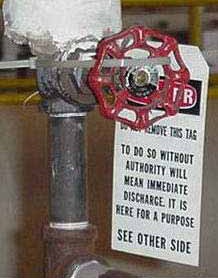ArticlesHave you ever seen/heard of this LOTO practice before?
The practice involved using a specially colored, self-locking, non-reusable nylon tie wrap (the color and design of these nylon tie wraps were specified in their written program) and a LOTO-prescribed tag to secure an isolation device in the safe position. Now, I will give credit here; the practice was to "secure" the isolation device in the "safe position." But when I read and observed the practice, this was a "tagout" and not a "lockout." The facility viewed this practice as a "lockout" since the nylon tie wrap(s) were the locking type and were being used to "secure" the isolation device in the "safe" position. No lock is used, only the specially colored nylon tie wraps and their prescribed LOTO tag. Here is more... |
Partner Organizations I am proud to announce that The Chlorine Institute and SAFTENG have extended our"Partners in Safety" agreement for another year (2024) CI Members, send me an e-mail to request your FREE SAFTENG membership
Member Associations
|
 Last year, we came across a very interesting LOTO practice that we completely disagreed with, but we were the only ones in the room who were not in agreement, so I think we may need to be "calibrated" in our LOTO expectations! I am not saying I will ever agree with this practice at a facility I am managing, but we were at a VPP site, and the safety professionals were truly world-class in many aspects of safety and health, so I thought maybe it was just me getting old and set in my ways.
Last year, we came across a very interesting LOTO practice that we completely disagreed with, but we were the only ones in the room who were not in agreement, so I think we may need to be "calibrated" in our LOTO expectations! I am not saying I will ever agree with this practice at a facility I am managing, but we were at a VPP site, and the safety professionals were truly world-class in many aspects of safety and health, so I thought maybe it was just me getting old and set in my ways. 













Comments
I would like to know why as well. I'm not saying I agree with the method; however, I'm also not ruling out the idea that there may be circumstances where it might make sense.
RSS feed for comments to this post